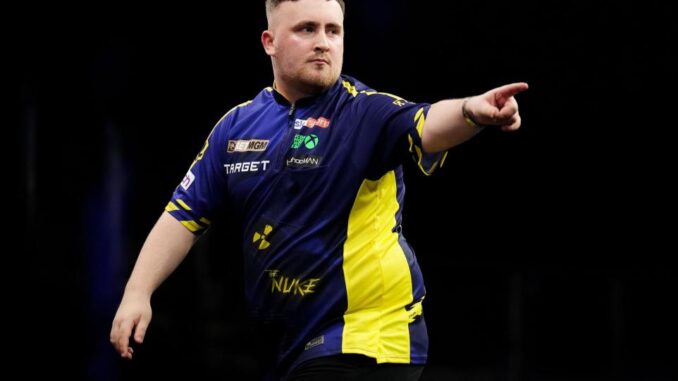
In the electric hum of Leicester’s Mattioli Arena, where the dartboard gleams like a beacon under the October spotlight, the 2025 BoyleSports World Grand Prix unfolds from October 6 to 12, transforming this industrial heartland into a crucible of darts drama. This isn’t just any tournament—it’s a gauntlet defined by its merciless “double in, double out” format, a PDC anomaly that demands players pierce a double or bullseye to begin and end each 501-point leg. With a £600,000 prize pool and £120,000 for the champion, the stakes are as sharp as the tungsten tips slicing through the air. Amid this high-wire act steps Luke Littler, the 18-year-old phenom dubbed “The Nuke,” whose meteoric 2025 has made him the bookmakers’ darling. Yet, beneath the swagger of a world champion lies a candid unease—a dread of the double-start format that has tripped him up before and threatens to derail his quest for Grand Prix glory.
Littler’s year has been a masterclass in domination, a relentless march that has rewritten darts history. Kicking off with a second World Championship title in January, he followed with a UK Open rout in March, tearing through Minehead with averages that flirted with perfection. July’s World Matchplay saw him obliterate Nathan Aspinall 18-7 in the semifinals before outlasting Luke Humphries for the £200,000 crown. World Series triumphs in Bahrain and New Zealand, plus a Premier League runner-up finish, pad his résumé with 15 titles, cementing his No. 2 ranking and fueling talk of an era-defining reign. “Littler is the clear favorite based on his results,” one pundit declares, capturing the awe that trails his every 180. But the Grand Prix, with its double-start quirk, is his kryptonite. His 2024 debut ended in a first-round upset against Rob Cross, a 2-1 sets loss where a missed double and Cross’s bullseye from 88 sealed his fate. It was a bitter echo of his World Matchplay quarterfinal exit that year, exposing a rare chink in his armor.
At a Manchester pop-up event last month, Littler’s honesty cut through the hype like a perfectly placed double 20. “Obviously it’s the next big one. I’ll be honest, I didn’t like it. I didn’t like the double start,” he admitted, his voice tinged with the weight of past failures. “I think it’s obviously one of the toughest tournaments to win, with the Worlds, the Matchplay, the Premier League. But the double start: if you don’t get off, then you’re in trouble.” It’s a stark confession from a player whose fluidity on tops and treble 20 feels effortless, yet the format’s demand for double precision at the outset—a dart landing on a treble leaves you stranded—has humbled giants before. “Every year we’ll see someone hit a treble 20 first out and then they forget,” Littler noted with a wry grin, alluding to the mental misstep that can unravel even the sharpest throwers. His preparation reflects the challenge: “I can’t say I really practice the double start often but obviously leading up to it I think I’ll have to, just get used to it.” For a player who thrives on instinct, this forced recalibration feels like rewriting muscle memory mid-battle.
Littler’s opening salvo on Tuesday, October 7, at 7:00 PM BST, pits him against Gian van Veen, a 20-year-old Dutch prodigy whose 2025 World Youth Championship crown and senior scalps make him a live wire. Their rivalry is electric: Littler crushed van Veen 10-4 in March’s UK Open quarters, but the Dutchman struck back with a 6-4 European Tour upset in September, averaging 110 to stun the field. “With this being a double start at the World Grand Prix it does feel like a different game but it is certainly not the draw Littler would have wanted,” warns an observer, highlighting van Veen’s knack for clutch doubles. A win here could propel Littler toward a quarterfinal clash with Gerwyn Price, the 2021 champ, or Josh Rock, both summer standouts whose raw power threatens to disrupt. Semifinals might bring world No. 1 Luke Humphries, who faces Aspinall in Monday’s opener, or defending champion Mike De Decker, whose 6-4 upset over Humphries last year shook the oche.
The Grand Prix’s schedule is relentless: first-round best-of-five sets span Monday to Wednesday, with second-round best-of-seven action on Thursday, October 9. Friday’s quarterfinals (best-of-nine) and Saturday’s semifinals (best-of-11) at 7:00 PM culiminate in Sunday’s 8:00 PM best-of-13 final, all broadcast live on Sky Sports. The field bristles with storylines—Michael van Gerwen, with six titles, meets debutant Niko Springer; Jonny Clayton, the 2022 victor, faces Ryan Searle; and icons Gary Anderson and Raymond van Barneveld collide in a nostalgic grudge match. Absences sting: Dave Chisnall, Michael Smith, and Dimitri Van den Bergh miss out, leaving gaps for new heroes. “Who knows how to find the doubles best under high stress?” ponders a darts scribe, evoking memories of nine-dart miracles like Brendan Dolan’s 2011 stunner or James Wade’s 2014 double-start gem.
For Littler, Leicester is a proving ground where his prodigious talent meets a format that scoffs at reputation. “He didn’t win two World Championship titles by luck, so I’m going in with the mindset that I have to play my A-game, like I do in every tournament,” he said, framing a potential Peter Wright clash but speaking to van Veen’s threat too. The double-start specter looms large—missed openers can spiral into blown legs, and blown legs into early exits. Yet, in the arena’s roar, Littler’s quest to master the unmasterable could redefine his legacy. Will he conquer his double-start dread, or will the format claim another scalp? As arrows fly and doubles dance, the Grand Prix awaits its next immortal chapter, with “The Nuke” poised to either detonate or defuse under pressure.
Leave a Reply